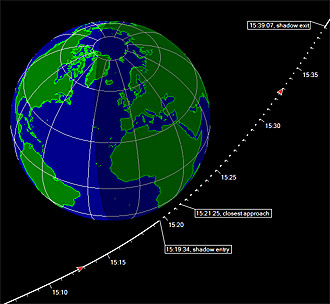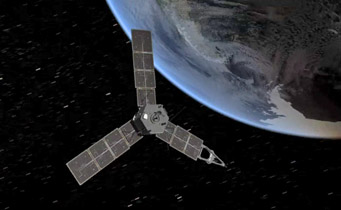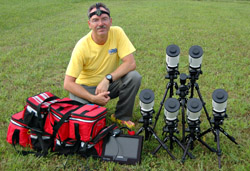NASA's Jupiter-bound spacecraft was in shadow when it swung over the southern tip of Africa at 19:21 UT on October 9th.

Juno is in shadow when skirts very close to Earth on October 9, 2013. Click on the image for a larger version.
Heavens-Above.com
These days, most interplanetary spacecraft take a roundabout route to reach their destination, and NASA's Juno is no exception. Launched two years ago, it still has three more years of cruising to complete before reaching Jupiter on July 5, 2016. To help it get there, the spacecraft is skirting past its home planet today to get a final energy boost.
At 19:21 Universal Time (3:21 p.m. Eastern Daylight Time), Juno will be just 347 miles (559 km) above sea level and swinging over the southern tip of Africa in darkness. "Juno will be really smoking as it passes Earth at a speed of about 25 miles per second relative to the Sun," notes Bill Kurth (University of Iowa), who is lead investigator for one of Juno’s nine scientific instruments.
The flyby, and tracking of the spacecraft by ground stations, is taking place as planned despite a funding impasse that has shut down the U.S. government, NASA included. The same "must-execute" operations exception occurred three days ago when the space agency's Lunar Atmosphere and Dust Environment Explorer (LADEE) fired its braking rocket to begin orbiting the Moon.

The flyby of NASA's Juno spacecraft on October 9, 2013, provides added velocity to boost the spacecraft toward its 2016 arrival at Jupiter.
NASA
"One of Juno’s activities during the Earth flyby will be to make a movie of the Earth-Moon system that will be the first to show Earth spinning on its axis from a distance," says Scott Bolton (Southwest Research Institute), principal investigator for the Juno mission.
Amateur astronomers will be trying to spot Juno as it swings by Earth. Juno will be over South America in daylight until 19:19:36 UT, when it slips into Earth's shadow at an altitude of 4,393 miles (7,069 km). Then, 18 minutes after its closest approach, Juno exits Earth's shadow when 9,255 miles (14,896 km) high and into view for observers in Europe and Asia.
Brightness estimates vary, but the craft's enormous solar-cell wings (29 feet long and 9 feet wide) might make the speeding spacecraft appear as bright as 9th magnitude — or briefly more obvious than that if sunlight should glint off of one of those big panels.
The Slooh telescope in the Canary Islands will be trained on Juno tonight beginning at 9:30 pm EDT (1:30 UT on October 10th). Slooh's Paul Cox will lead a team offering commentary during the event. You can watch by going to slooh.com.

Scott Degenhardt shows off a highly portable seven-camera setup that he uses to record occultations by asteroids. He'll be webcasting from his home in New Mexico during Juno's flyby.
Scott Degenhardt
Meanwhile, Scott Degenhardt plans to webcast two attempts to spot Juno as it drifts past relatively bright stars. These windows come on October 10th at 6:45– 7:45 and 9:15–10:15 UT. He invites you to tune in but cautions that a weather front is approaching his site in New Mexico that could bring high winds and clouds. "I am being optimistic in believing the craft will be on par with the field stars (10th to 12th magnitude)," Degenhardt says.
If you want to try spotting Juno yourself, you can get location predictions from Chris Peat's Heavens Above website.
Amateur radio operators can also participate in "Say Hi to Juno," which will send a coordinated Morse code message to the spacecraft. Burnett's radio- and plasma-wave experiment, called Waves, should be able to detect the message if enough hams participate.
Once it reaches Jupiter, Juno will orbit the planet pole to pole, coming within 1.75 million miles of the colorful Jovian cloud tops every 11 days. Although NASA's website is down, you can read more about the mission here.
 4
4
Comments
Andrew
October 10, 2013 at 10:09 am
Is it true that a slight shadow is moving on the Moon? Why don't NASA give us news? I've seen this news here http://deepspace-explorer.blogspot.it/
You must be logged in to post a comment.
David Jessie
October 11, 2013 at 11:06 am
The article state: "At 19:21 Universal Time (5:21 p.m. Eastern Daylight Time), Juno will be just 347 miles (559 km) above sea level" Unless I can't subtract today, isn't that an error? Shouldn't it read as follows: "At 19:21 Universal Time (3:21 p.m. Eastern Daylight Time), Juno will be just 347 miles (559 km) above sea level" since Eastern Daylight Time is UTC - 4 hours?
You must be logged in to post a comment.
Ted A. Hunt
October 11, 2013 at 5:33 pm
According to the counter at missionjuno.swri.edu/earth-flyby , now displaying time lapsed since the fly-by, you are entirely correct. The fly-by was around 3:21pm EDT Oct 9. Kelly Beatty's UT time is correct.
The probability of a trifling error like this is directly proportional to the number of people who'll see it. ☺
You must be logged in to post a comment.
Kelly Beatty
October 14, 2013 at 8:11 am
hi, Jessie... you're right: the EDT should have been 3:21 pm. I've corrected it.
You must be logged in to post a comment.
You must be logged in to post a comment.